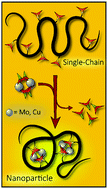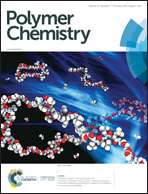M24+ paddlewheel clusters as junction points in single-chain nanoparticles†
Abstract
We report the formation of well-defined copper and molybdenum single-chain nanoparticles, exhibiting metal clusters (M24+) as junction points. Upon addition of dimetallic precursor complexes [Cu2(OAc)4] and [Mo2(OAc)4], carboxylic acid functionalized polymer chains collapse into nanoparticles containing a M24+ (M = Cu, Mo) centered paddlewheel folding moiety. This synthetic strategy allows a high crosslinking per metal unit and the incorporation of an adjustable number of dimetallic centers into a single polymer chain. The successful formation of M2-SCNPs is evidenced by size exclusion chromatography and diffusion-ordered NMR spectroscopy. Detailed insight into the dimetallic folding unit is provided by 1H/2H NMR-, IR-, Raman- and UV-Vis spectroscopy as well as comparative analyses of molecular dicopper and dimolybdenum model-complexes. For the first time, M24+ paddlewheel folding motifs, including quadruple bonded dimetallic units, as in the case of Mo24+, are utilized as structure forming elements in the realm of SCNP chemistry.



 Please wait while we load your content...
Please wait while we load your content...